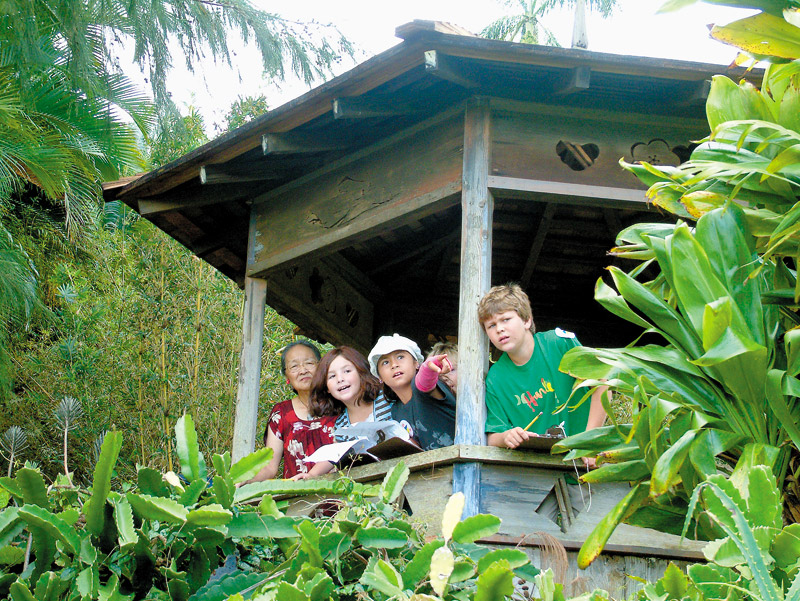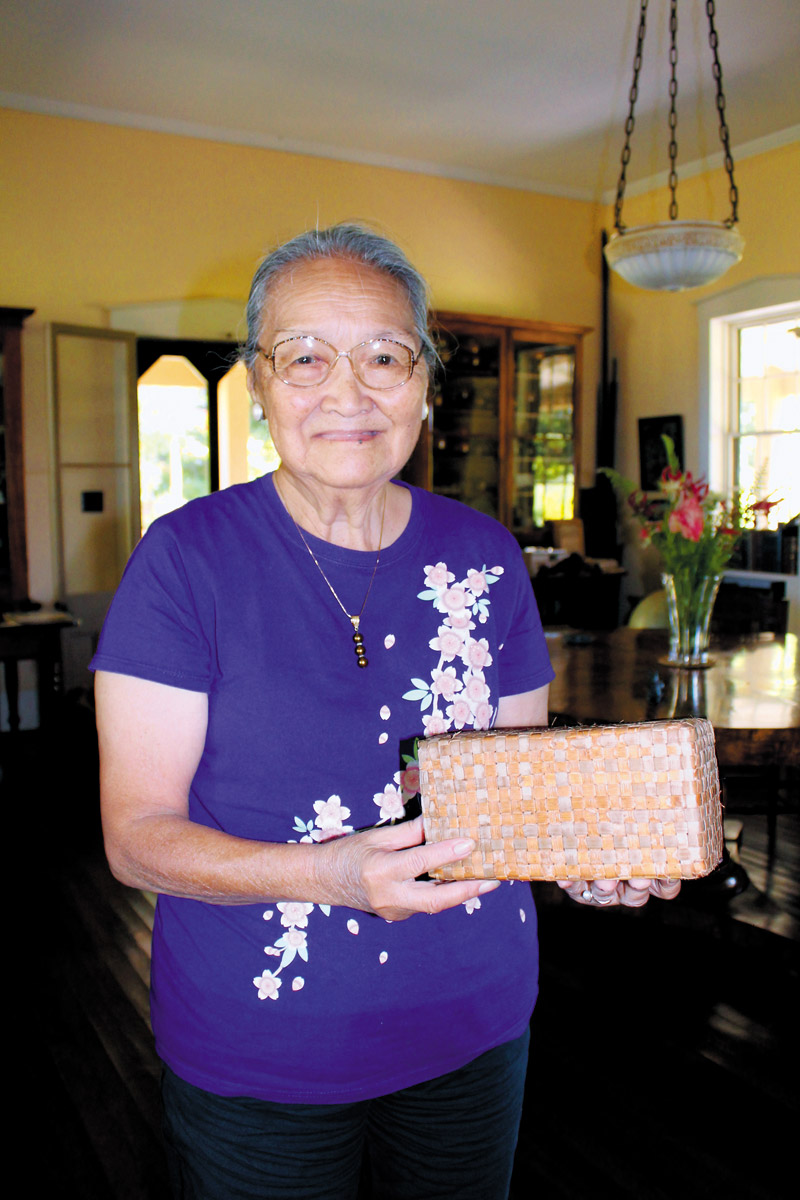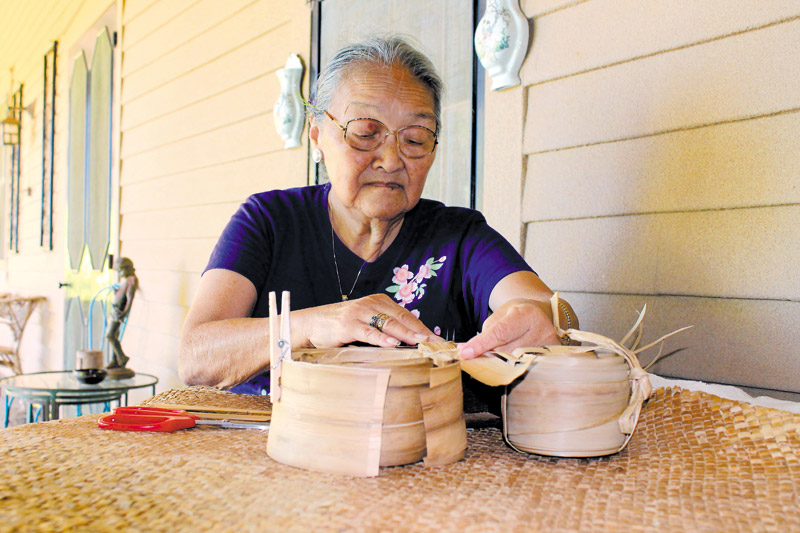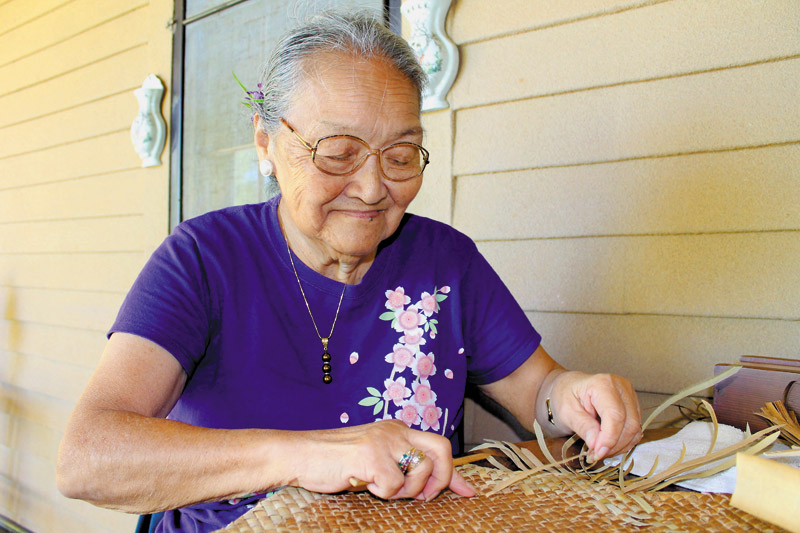Dream Weaver

Kelekoma and a group of students from Hanalei School look out from the homestead’s tea house during a 2007 tour. PHOTO COURTESY GROVE FARM SUGAR PLANTATION MUSEUM
Few people have more love for the ancient Hawaiian craft of Lauhala Weaving than Tomie Kelekoma, a skilled artisan who’s behind a restoration effort at Grove Farm Sugar Plantation Museum.
Tomie Kelekoma possesses the rare capacity to sit patiently for hours, intricately weaving dried leaves from the hala tree to create decorative and practical items such as baskets and bracelets. In an era when it’s easier to run to the store and purchase products made in bulk, Kelekoma still cherishes the beauty in handmade items.
People are “spoiled” with too many machines today, she says one day while at the Grove Farm Sugar Plantation Museum, where she’s restoring all of the homestead’s lauhala weavings, including mats and doorstops.
“The true way of doing things back in the old days are more durable,” explains Kelekoma as her hands nimbly cut and entwine hala leaves.

Tomie Kelekoma is helping restore the lauhala weavings, including door stops, at Grove Farm Sugar Plantation Museum.
These days it’s also easy to buy the leaves (lau) from the hala tree pre-rolled and ready to split into thin pieces for weaving, but she remembers the “old fashioned” way when practitioners would pluck the spindly leaves of the native plant, boil them and lay them on the ground to dry before rolling, thinning and splicing.
Lauhala weaving is an ancient Hawaiian craft. The hala tree, which is easily recognized by its distinctive spidery roots, pineapple-looking fruit and poofs of long thorny leaves, is an iconic plant throughout Polynesia, where it grows naturally. Hawaiians used lauhala weavings for pragmatic purposes like mats, sails, mattresses and baskets. Families would also have their own signature style and designs. Accessories like hats and bracelets are believed to have come about later due to Western influence.
Though Kelekoma doesn’t have Hawaiian ancestral roots (she is of Japanese descent), she has always embraced the cultural activities of her native birthplace. She has a particular affinity for the arts, including the elusive craft of Hawaiian quilting — another skill that requires perseverance, as everything is hand-stitched.

Tomie Kelekoma is happy to spend hours weaving the lau, or leaves, of the hala tree at Grove Farm Sugar Plantation Museum.
“You just have to make sure that when you quilt, your mind has to be only on quilting and not doing laundry,” says Kelekoma, who heeds her own advice lest she get poked by the needle.
But her primary focus right now is replacing the brown, tattered bits and edges of the worn lauhala weavings at Grove Farm Sugar Plantation Museum. The task is even more vital to her, as she’s one of the few people with the artistic skills and willingness to do so.
“Tomie is a beautiful woman with a disposition of a saint,” says Carla Kaser, a volunteer tour guide at the museum, who often sees Kelekoma plugging away at her craft. “She has the true aloha spirit.”
Robert Schleck, Grove Farm Sugar Plantation Museum’s director, couldn’t agree more. He’s worked with Kelekoma since 1996 when she was employed by the organization as a guide — she later became housekeeper prior to retiring.
“She is a perfect model of an island person, with quiet grace and dedicated caretaking,” he says.
Kelekoma, whose father was employed by Grove Farm Co., was born in Hulē‘ia before her family moved to Halehaka valley when she was 5. Her Līhu‘e roots run deep.
“I never left the rock,” she says. And even though she’s traveled to places like Tahiti, California and Las Vegas, the Kaua‘i High School alumna never had a desire to move away from her home-town. She still has fond memories of pastimes like collecting Kaua‘i Soda Co. bottles that she foraged for around her neighborhood – some of which she still has that are now valuable vintage items.
“I really wasn’t interested in the money part when I went looking. I just liked to go with my friend and spend the day in the dirt,” says Kelekoma, who was married to the late Alexander “Alika” Manoiki, with whom she had 12 children.
Her interest in antique items, as well as historical crafts, persists to this day and is evidenced by her desire to continue practicing the ancient art of lauhala weaving. She likes the ability to concentrate on such meticulous work.
“It helps me stay away from grumbling,” she jokes.
And, of course, it builds that noble quality of patience.
“A lot of opportunities come out when you’re patient,” says Kelekoma, who would love if more people would take interest in working with their hands. “For me, it’s a challenge because I have a lot of other things to do, too. But when you find something you like to do, you just find the time.”
cocomidweek@gmail.com




